Biogipuzkoa
Centro de investigación


St George's, University of London
Londres, Reino UnidoPublicaciones en colaboración con investigadores/as de St George's, University of London (12)
2024
-
Clinical and neuroradiological spectrum of biallelic variants in NOTCH3
eBioMedicine, Vol. 107
2023
-
Causes of death in children with congenital anomalies up to age 10 in eight European countries
BMJ Paediatrics Open, Vol. 7, Núm. 1
-
Diminishing benefits of urban living for children and adolescents’ growth and development
Nature, Vol. 615, Núm. 7954, pp. 874-883
-
Ethics and legal requirements for data linkage in 14 European countries for children with congenital anomalies
BMJ Open, Vol. 13, Núm. 7
2022
-
Temporal and geographical variations in survival of children born with congenital anomalies in Europe: A multi-registry cohort study
Paediatric and Perinatal Epidemiology, Vol. 36, Núm. 6, pp. 792-803
-
Validation of the OAKS prognostic model for acute kidney injury after gastrointestinal surgery
BJS Open, Vol. 6, Núm. 1
2021
-
Heterogeneous contributions of change in population distribution of body mass index to change in obesity and underweight
eLife, Vol. 10
-
Signal Detection in EUROmediCAT: Identification and Evaluation of Medication–Congenital Anomaly Associations and Use of VigiBase as a Complementary Source of Reference
Drug Safety, Vol. 44, Núm. 7, pp. 765-785
2020
-
Recurrent De Novo NAHR Reciprocal Duplications in the ATAD3 Gene Cluster Cause a Neurogenetic Trait with Perturbed Cholesterol and Mitochondrial Metabolism
American Journal of Human Genetics, Vol. 106, Núm. 2, pp. 272-279
2016
-
Is prolonged infusion of piperacillin/tazobactam and meropenem in critically ill patients associated with improved pharmacokinetic/pharmacodynamic and patient outcomes? An observation from the Defining Antibiotic Levels in Intensive care unit patients (DALI) cohort
Journal of Antimicrobial Chemotherapy, Vol. 71, Núm. 1, pp. 196-207
2012
-
Mortality after surgery in Europe: A 7 day cohort study
The Lancet, Vol. 380, Núm. 9847, pp. 1059-1065
2003
-
PIP2 binding residues of Kir2.1 are common targets of mutations causing Andersen syndrome
Neurology, Vol. 60, Núm. 11, pp. 1811-1816